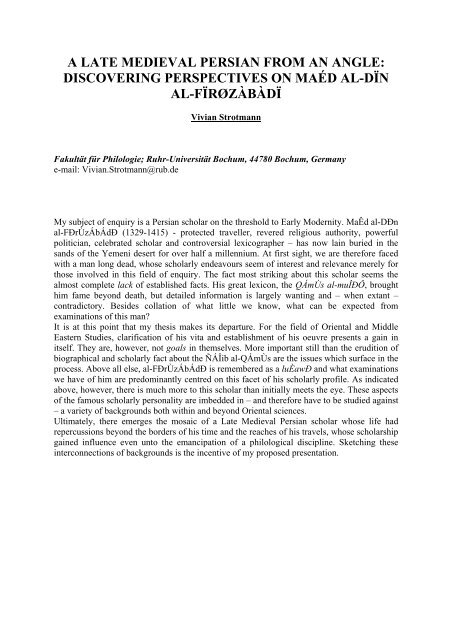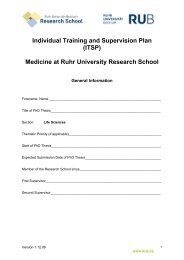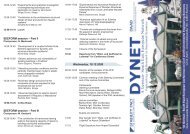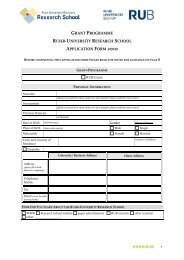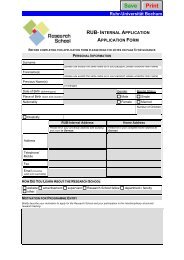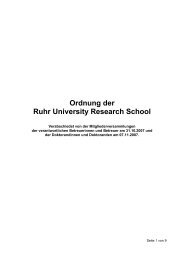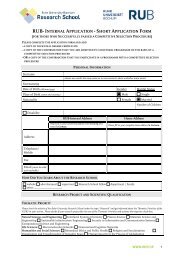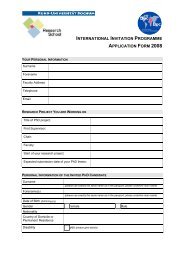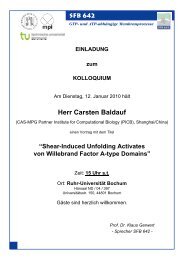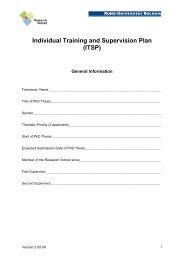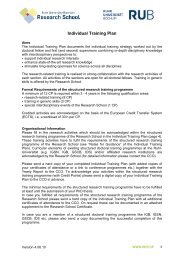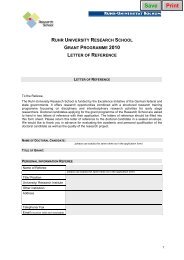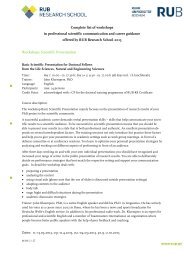Section Days abstract book 2010.indd - RUB Research School ...
Section Days abstract book 2010.indd - RUB Research School ...
Section Days abstract book 2010.indd - RUB Research School ...
Create successful ePaper yourself
Turn your PDF publications into a flip-book with our unique Google optimized e-Paper software.
A LATE MEDIEVAL PERSIAN FROM AN ANGLE:<br />
DISCOVERING PERSPECTIVES ON MAÉD AL-DÏN<br />
AL-FÏRØZÀBÀDÏ<br />
Vivian Strotmann<br />
Fakultät für Philologie; Ruhr-Universität Bochum, 44780 Bochum, Germany<br />
e-mail: Vivian.Strotmann@rub.de<br />
My subject of enquiry is a Persian scholar on the threshold to Early Modernity. MaÊd al-DÐn<br />
al-FÐrÙzÁbÁdÐ (1329-1415) - protected traveller, revered religious authority, powerful<br />
politician, celebrated scholar and controversial lexicographer – has now lain buried in the<br />
sands of the Yemeni desert for over half a millennium. At first sight, we are therefore faced<br />
with a man long dead, whose scholarly endeavours seem of interest and relevance merely for<br />
those involved in this field of enquiry. The fact most striking about this scholar seems the<br />
almost complete lack of established facts. His great lexicon, the QÁmÙs al-muÎÐÔ, brought<br />
him fame beyond death, but detailed information is largely wanting and – when extant –<br />
contradictory. Besides collation of what little we know, what can be expected from<br />
examinations of this man?<br />
It is at this point that my thesis makes its departure. For the field of Oriental and Middle<br />
Eastern Studies, clarification of his vita and establishment of his oeuvre presents a gain in<br />
itself. They are, however, not goals in themselves. More important still than the erudition of<br />
biographical and scholarly fact about the ÑÁÎib al-QÁmÙs are the issues which surface in the<br />
process. Above all else, al-FÐrÙzÁbÁdÐ is remembered as a luÈawÐ and what examinations<br />
we have of him are predominantly centred on this facet of his scholarly profile. As indicated<br />
above, however, there is much more to this scholar than initially meets the eye. These aspects<br />
of the famous scholarly personality are imbedded in – and therefore have to be studied against<br />
– a variety of backgrounds both within and beyond Oriental sciences.<br />
Ultimately, there emerges the mosaic of a Late Medieval Persian scholar whose life had<br />
repercussions beyond the borders of his time and the reaches of his travels, whose scholarship<br />
gained influence even unto the emancipation of a philological discipline. Sketching these<br />
interconnections of backgrounds is the incentive of my proposed presentation.


